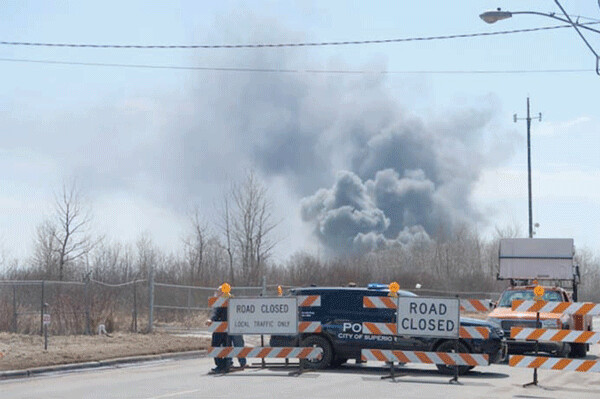News & Articles
Browse all content by date.

In “A Risk Too Great: Hydrofluoric Acid in US Refineries,” the United Steelworkers (USW) union has a report that all Twin Ports residents should read. The 23-page review explains what’s so deadly and dangerous about Husky Energy’s continued use of “HF” at the Superior refinery and why it shouldn’t be allowed.
HF is a ferocious contact poison capable of causing blindness, cardiac arrest and agonizing deaths. It burns through soft tissues such as skin, eyes, lungs and GI tract, and seeks the bones. HF even interferes with nerve function, so that symptoms may not be immediate and burns may not initially be painful. The Center for Public Integrity (CPI) has found that “in a worst-case scenario, the amount used at the Superior refinery could seriously injure or kill up to 180,000 people in the Twin Ports area if the tank holding the hydrogen fluoride were compromised,” the StarTribune reported.
Husky’s refinery reportedly held about 15,000 pounds of the toxic material at the time of the fire. As the USW’s report, completed in April 2013, makes clear, there are now “processes that are much safer than either sulfuric acid or HF.” Local mayors have seen the light.
Jim Paine of Superior wrote May 1st that he “asked them [Husky Energy] to discontinue” all use of hydrofluoric acid “and to report back to me on any … challenges that might prevent them from doing so.” Duluth Mayor Emily Larson wrote in a news release that she joined Paine’s demand and wanted to strengthen it. “Choosing the known risks of hydrogen fluoride is not …being a good corporate partner. It elevates danger to our environment and our people,” Larson wrote.
The combination of the hair-raising April 26 explosions and fires, the CPI study, this USW report, and enough public pressure, can bring further use of HF by Husky to an end. The community only needs to prod the mayors to overcome roadblocks and delays designed to dilute this common sense demand and to push aside distracting or obstructionist tactics of Governor Walker and the Wisconsin Manufacturers and Commerce who will say corporate tax breaks aren’t for safety improvements.
As the Steelworkers remind us that, “In April 2011, Dr. Rafael Moure-Eraso, Chairperson of US Chemical Safety Board said, ‘Serious incidents at refineries continue to occur with alarming frequency.’ ” (April 26 was the anniversary of Chernobyl.) “The trail of US refinery disasters and non-compliance with regulations is a potent reminder of the potential for catastrophe,” the USW report says. A few US refinery accidents with hydrofluoric acid give fair warning:
• On March 5, 2012, at the CITGO refinery in Corpus Christi, TX an HF leak of between 300 and 500 pounds took place from a flange with a history of leaks. The line had been temporarily repaired with clamps on several occasions while CITGO continued running.
• In Ohio, on Feb. 28, 2017 Marathon Canton caused a refinery leak of what the company estimated to be 145 pounds of HF.
• Also at CITGO Corpus Christi, a July 19, 2009 explosion and fire burned for two days. About 42,000 pounds of HF was released and a sprinkler system failed to “knock down” the HF vapors. An estimated 4,200 pounds of HF traveled beyond the property line, and pure luck — like with the Superior explosions and fires — saw wind push the plume toward an unpopulated area.
• At Sunoco Co. in Philadelphia March 11, 2009, a release of HF sent 13 workers to hospitals because of exposure to a 22-pound release of HF.
• On April 8, 2004, at Giant Industries Refinery in Jamestown, NM, flammable gasoline components caught fire near the HF unit injuring six employees, four with burns requiring hospitalization.
• On October 30, 1987 the Marathon Corp. in Texas City, TX caused the worst and scariest refinery release of HF vapors in US history. Fifty-square blocks were evacuated and over 900 people received hospital treatment for injuries. As in Superior, wind direction kept the incident from being even worse.
After the 2005 BP Texas City Refinery disaster, the Steelworkers published “Beyond Texas City: The State of Process Safety In The Unionized US Oil Refining Industry.” This report looked at conditions at 51 unionized refineries and found that highly hazardous conditions were pervasive. “The study concluded that the refining industry is ripe for future disasters,” the newer USW report says.
The 2013 USW study also warns: “The potential impact of a large-scale HF release in a heavily populated area is so great that it may be impossible for any refiner or community to be fully prepared. Even highly effective systems sometimes fail. It would take multiple failures to trigger a major release, but the lesson of catastrophic accidents from Bhopal to the Deepwater Horizon [to Fukushima] is that multiple failures can occur.”
Alternatives like solid acid catalyst systems and an ionic liquid process both eliminate the use of either HF or sulfuric acid. “Substitution of a less dangerous chemical for a highly toxic one is … promoted by the American Institute of Chemical Engineers and its Center for Chemical Process Safety,” the USW says.
These alternatives “are produced without the dangers to workers, communities and the environment posed by current processes.” It seems gang at Husky Energy only needs to be pushed hard enough by us.
| Tweet |

